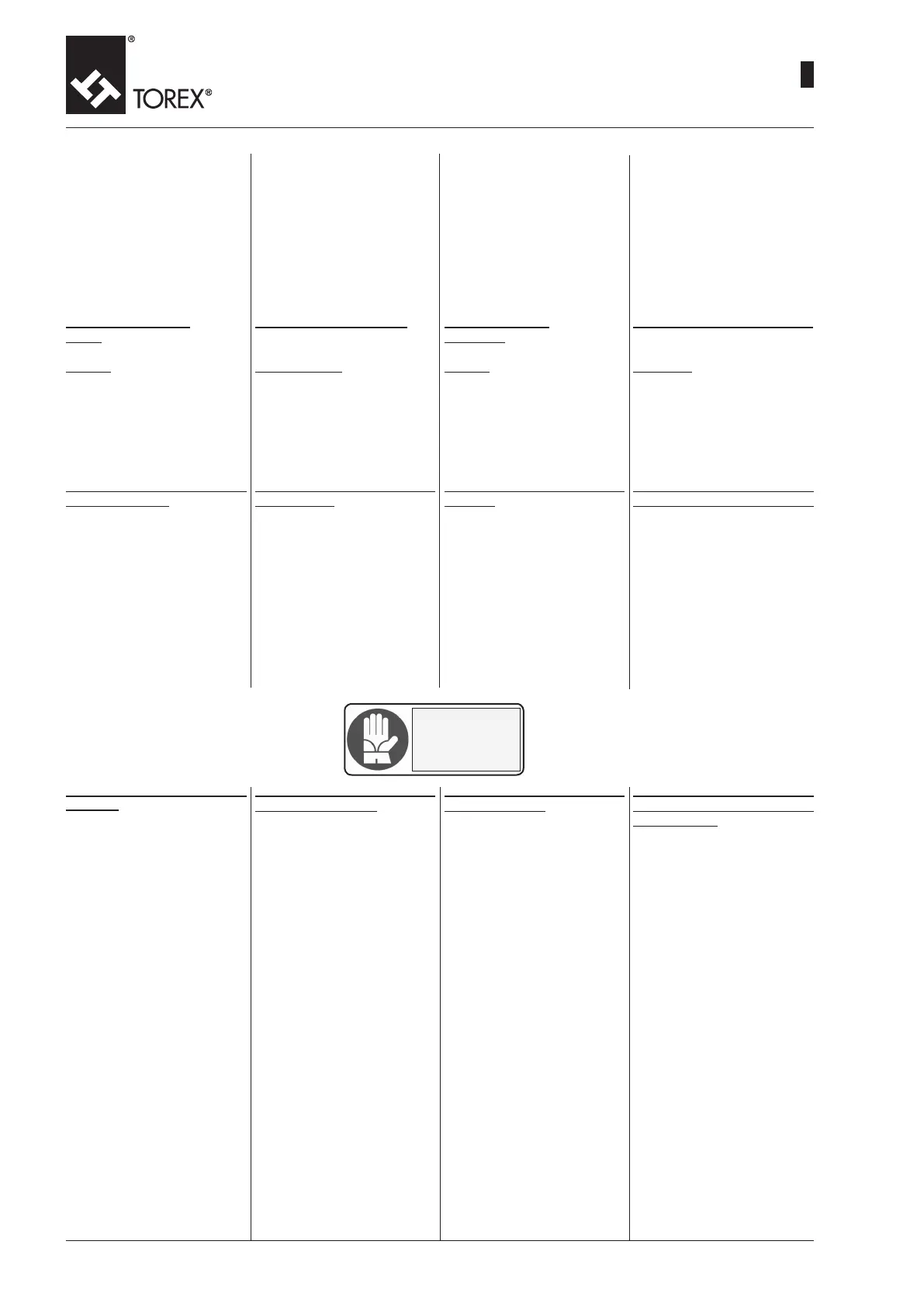2
TOR.089.--.M.4L-PL
09.16
-
-
-
-
RV
RVR
Mimo, że na etapie projektowania
i konstrukcji śluzy celkowej wyeli-
minowano większość zagrożeń,
istnieją jednak pewne ryzyka reszt-
kowe, których nie da się usunąć i
dla których należy przewidzieć ko-
munikaty ostrzegawcze i instrukcje
dla operatorów, a także specjalne
środki ochrony indywidualnej.
Zagrożenianaturymechanicznej
Stabilność
Podnoszenie i przemieszczanie
śluzy celkowej winny odbywać się
zgodnie z zaleceniami podanymi w
tej instrukcji (część 2 dokumentacji,
sekcja „TRANSPORT - MASY-POD-
NOSZENIE”).
Zagrożeniazwiązanezpowierzch-
niami,krawędziamiinarożnikami
Zwłaszcza podczas prowadzenia
prac konserwacyjnych personel
powinien używać odpowiednich
środków ochrony indywidualnej (rę-
kawic chroniących przed przecię-
ciami, odzieży ochronnej, Obuwia
ochronnego), aby uniknąć urazów
ciała spowodowanych kontaktem z
ostrymi powierzchniami lub naroż-
nikami niektórych elementów śluzy
(patrz część 2 dokumentacji, sekcje
„WSKAZÓWKI” i „KONSERWACJA”).
Zapobieganiezagrożeniomzwią-
zanymz ruchomymi częściami
śluzycelkowej.
W przypadku prawidłowej instalacji
śluzy celkowej dostęp do jakich-
kolwiek ruchomych części jest nie-
możliwy. Więcej informacji na ten
temat można znaleźć w innej części
instrukcji (instrukcja RV-RVR (część
2), sekcje „WSKAZÓWKI” i „KON-
SERWACJA”; instrukcja RVS/C
(część 2), sekcje „INSTALACJA”,
„OGÓLNE ŚRODKI OSTROŻNO-
ŚCI” i „INSTRUKCJA OBSŁUGI I
KONSERWACJI „).
W przypadku śluz celkowych z
napędem łańcuchowym układ łań-
cuch-koła łańcuchowe zabezpie-
czony jest osłoną, której nie można
usunąć, dopóki maszyna nie znaj-
dzie się w bezpiecznym stanie. W
przypadku prac konserwacyjnych
lub ingerencji w maszynę, podczas
których uzyskuje się dostęp do
ruchomych części, należy ściśle
przestrzegać procedur opisanych w
tej instrukcji (część 2 dokumentacji,
sekcja „KONSERWACJA”).
RESIDUALRISKS
RESTRISIKEN
RISQUESRESIDUELS
POZOSTAŁERYZYKA
40
Obwohl die Planung und Konstruk-
tion der Zellenradschleuseeinige
Risiken beseitigt hat, bleiben doch
einige Restrisiken noch bestehen,
die sich nicht beseitigen lassen und
für die Meldungen und Anweisungen
für die Bediener erforderlich sind,
sowie auch besondere Maßnahmen
bei der Benutzung des Geräts.
GefahrenmechanischerArt
Standsicherheit
Handling und Heben der Zellen-
radschleuse sind so auszuführen,
dass die Angaben des Handbuchs
beachtet werden (Kap. 2 Abschnitt
„TRANSPORT – GEWICHTE -
HEBEN”).
RisikendurchOberächen,Kan-
tenundEcken
Insbesondere bei der Wartung sind
persönliche Schutzausrüstungen
(Schnittschutzhandschuhe, Schutz-
kleidung, Unfallschutzschuhwerk)
zu benutzen, um Verletzungen
durch schneidende oder eckige
Oberächen einiger Komponenten
zu vermeiden (siehe Handbuch
Kap. 2 Abs. „HINWEISE” und „WAR-
TUNG”).
Bien que l’étude de projet et la fabri-
cation du distributeur alvéolaire
aient éliminé plusieurs risques à
l’origine, il existe des risques rési-
duels non évaluables qui exigent
des signalisations et des instructions
pour les opérateurs et des précau-
tions particulières lors de l’utilisation
de la machine.
Dangersdenature
mécanique
Stabilité
La manutention et le soulèvement
du distributeur doivent être faits en
respectant les indications du manuel
(Chap. 2 Section « TRANSPORT-
POIDS-LEVAGE).
Risquesdusauxsurfaces,arêtes
etangles
Notamment dans les phases de
manutention, il faut utiliser des équi-
pements de protection individuelle
(gants anti-coupure, vêtements de
protection, chaussures de sécurité),
pour éviter les blessures sur les
surfaces coupantes ou les arêtes
vives de certains composants. (Voir
Manuel Chap.2 Section « AVERTIS-
SEMENTS » et « ENTRETIEN »).
Although certain risks have been
eliminated at the origin in the ro-
taryvalvedesign and construction
phase, certain residual risks still
persist for which warning signs and
instructions are required for the
operators and special measures
have to be adopted in the use of
the machine.
Dangerofmechanical
nature
Stability
Handling and lifting of the valve must
be done according to the indica-
tions given in the Manual (Chap.2
Section “TRANSPORT-WEIGHTS-
LIFTING).
Risks due to surfaces, sharp
edgesandcorners
Particularly in the maintenance
steps, it is necessary to use personal
protection equipment (cut-proof
gloves, protective clothing, safety
footwear), to avoid injury due to
sharp and cutting surfaces and
edges of certain components. (See
Manual Chap.2 Section “WARN-
INGS” and “MAINTENANCE”).
Preventionof risksduetomov-
ingparts.
In the correct installation of the
diverter valve, all accesses to mov-
ing parts are closed: in this regard,
refer to the Manual (Manual RV,
Chap.2 Sect. “WARNINGS” and
“INSTALLATION”, Manual RVS/C,
Chap.2 Sect. “INSTALLATION” and
“GENERAL PRECAUTIONS”, “USE
AND MAINTENANCE”).
In rotary valves with chain trans-
mission, the chain-sprocket unit is
protected by a guard which must not
be removed unless the machine has
been set in safety condition.
In the maintenance steps or in case
of actions which may make the mov-
ing parts accessible, refer to the
procedures described in the Manual
(Chap.2 Sect. “MAINTENANCE”).
Préventiondes risquesdusaux
élémentsmobiles.
La mise en place correcte du distri-
buteur prévoit la fermeture de tous
les accès aux parties mobiles : voir
à ce propos le manuel (Manuel RV,
Chap.2 Sect.”AVERTISSEMENTS”
et “MISE EN PLACE”, Manuel
RVS/C, Chap.2 Sect.”MISE EN
PLACE” et “PRECAUTIONS
GENERALES”,”UTILISATION ET
ENTRETIEN”).
Dans les distributeurs alvéolaires à
transmission par chaîne, le groupe
chaîne-pignons est protégé par un
carter qui ne doit pas être enlevé
avant la mise en sécurité de la
machine.
Dans les phases d’entretien ou
en cas d’interventions exigeant
l’accès à des parties mobiles, faire
référence aux procédures décrites
dans le manuel (Chap.2 Sect.
« ENTRETIEN »).
Vermeidungder Risiken infolge
beweglicherElemente
Die korrekte Installation der Schleu-
se sieht vor, dass alle Zugänge zu
den beweglichen Teilen geschlos-
sen werden: In diesem Zusammen-
hang ist Bezug auf das Handbuch
zu nehmen (Handbuch RV, Kap. 2
Abs. „HINWEISE” und „WARTUNG”,
Handbuch RVS/C, Kap. 2, Abs. „IN-
STALLATION” und „ALLGEMEINE
VORSICHTSMASSNAHMEN” und
„GEBRAUCH UND WARTUNG”).
Bei den Zellenradschleusen mit
Kettentrieb wird die Gruppe Ketten-
Kettenrad durch eine Verkleidung
geschützt, die nicht entfernt werden
darf, bevor die Maschine sich nicht
im sicheren Zustand bendet.
Bei der Wartung oder beim Ein-
griffen, bei denen die beweglichen
Teile zugänglich werden, ist Bezug
auf die Verfahren zu nehmen, die
im Handbuch beschrieben werden
(Kap.2 Abs. „WARTUNG”).
